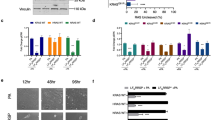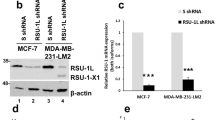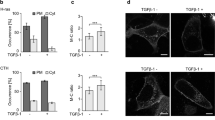Abstract
To search for the signaling pathway critical for tumor invasion, we examined the effects of dominant negative ras (S17N ras) expression on the activation of matrix metalloproteinase-2 (MMP-2) in src-transformed 3Y1, SR3Y1, under the control of conditionally inducible promoter. In SR3Y1 clones transfected with S17N ras, augmented secretion and proteolytic activation of MMP-2 were dramatically suppressed by S17N Ras expression, while tyrosine phosphorylation of cellular proteins was not suppressed. We found that invasiveness of SR3Y1 cells assayed by the modified Boyden Chamber method was strongly suppressed by S17N Ras expression. In contrast, cell morphology reverted partially and glucose uptake remained unchanged by S17N Ras expression. In addition, treatment of SR3Y1 with manumycin A, a potent inhibitor of Ras farnesyltransferase, strongly suppressed both augmented secretion and proteolytic activation of MMP-2. Contrary, treatment of SR3Y1 with wortmannin or TPA showed no clear effect on MMP-2 activation. Thus, these results strongly suggest that Ras-signaling, but neither P13 kinase- nor protein kinase C-signalings, plays a critical role in activation of MMP-2 and, subsequently, in the invasiveness of src-transformed cells.
This is a preview of subscription content, access via your institution
Access options
Subscribe to this journal
Receive 50 print issues and online access
$259.00 per year
only $5.18 per issue
Buy this article
- Purchase on Springer Link
- Instant access to full article PDF
Prices may be subject to local taxes which are calculated during checkout








Similar content being viewed by others
References
Aftab DT, Kwan J and Martin GS. . 1997 Proc. Natl. Acad. Sci. USA 94: 3028–3033.
Albini A, Iwamoto Y, Kleinman HK, Martin GR, Aaroson SA, Kozlowski JM and McEwan RN. . 1987 Cancer Res. 47: 3239–3245.
Bromberg JF, Horvath CM, Besser D, Lathem WW and Darnell Jr JE. . 1998 Mol. Cell. Biol. 18: 2553–2558.
Burr JG, Dreyfuss G, Penmann S and Buchanan JM. . 1980 Proc. Natl. Acad. Sci. USA 77: 3484–3488.
Campbell SL, Khosravi-Far R, Rossman KL, Clark GJ and Channing JD. . 1998 Oncogene 17: 1395–1413.
Cao X, Tay A, Guy GR and Tan YH. . 1996 Mol. Cell. Biol. 16: 1595–1603.
Chang HW, Aoki M, Fruman D, Auger KR, Bellacosa A, Tsichlis PN, Cantley LC, Roberts TM and Vogt PK. . 1997 Science 276: 1848–1850.
Collet MS and Erikson RL. . 1978 Proc. Natl. Acad. Sci. USA 75: 2021–2024.
Collier IE, Wilhelm SM, Eisen AZ, Marmer BL, Grant GA, Seltzer JL, Kronberger A, He C, Bauer EA and Goldberg GI. . 1988 J. Biol. Chem. 263: 6579–6587.
DeClue JE, Zhang K, Redford P, Vass WC and Lowy DR. . 1991 Mol. Cell. Biol. 11: 2819–2825.
Feig AL and Cooper MG. . 1988 Mol. Cell. Biol. 8: 3235–3243.
Fukui Y and Hanafusa H. . 1989 Mol. Cell. Biol. 9: 1651–1658.
Hamaguchi M, Yamagata S, Thant AA, Xiao H, Iwata H, Mazaki T and Hanafusa H. . 1995 Oncogene 10: 1037–1043.
Hamaguchi M, Matsuyoshi N, Ohnishi Y, Gotoh B, Takeichi M and Nagai Y. . 1993a EMBO J. 12: 307–314.
Hamaguchi M, Xiao H, Uehara Y, Ohnishi Y and Nagai Y. . 1993b Oncogene 8: 559–564.
Hamaguchi M, Matsuda M and Hanafusa H. . 1990 Mol. Cell. Biol. 10: 830–836.
Hamaguchi M, Grandori C and Hanafusa H. . 1988 Mol. Cell. Biol. 8: 3035–3042.
Hamaguchi M and Hanafusa H. . 1987 Proc. Natl. Acad. Sci. USA 84: 2312–2316.
Hanafusa H. . 1977 Comprehensive Virology. Vol. 10. Frankel-Conrat H and Wagner RW. (eds).. Plenum Press: New York pp. 401–483.
Hatanaka M and Hanafusa H. . 1970 Virology 41: 647–652.
Kataoka M, Yamagata S, Akiyama S, Watanabe T, Takagi H, Thant AA, Iida K, Saga S, Kishi J and Hamaguchi M. . 1996 Int. J. Oncol. 8: 773–779.
Kawai S. . 1980 J. Virol. 34: 772–776.
Kawai S and Hanafusa H. . 1971 Virology 46: 470–472.
Klein NP and Schneider RJ. . 1997 Mol. Cell. Biol. 17: 6427–6436.
Levinson AD, Oppermann H, Levintow L, Varmus HE and Bishop JM. . 1978 Cell 15: 561–572.
Liotta LA. . 1986 Cancer Res. 46: 1–7.
Matriasian LM. . 1990 Trends Genet. 6: 121–125.
Mullins DE and Rohrlich ST. . 1983 Biochem. Biophys. Acta 695: 177–214.
Nori M, Vogel US, Bibbs JB and Weber MJ. . 1991 Mol. Cell. Biol. 11: 2812–2818.
Ohtani H, Nagai T and Nagura H. . 1995 Jpn. J. Cancer Res. 86: 833–839.
Okada A, Jean-Pierrre B, Nicolas R, Marie-Pierre C, Marie-Christine R, Pierre C and Paul B. . 1995 Proc. Natl. Acad. Sci. USA 92: 2730–2734.
Pyke C, Ralfkiaer E, Huhtala P, Hurskainen T, Dano K and Tryggvason K. . 1992 Cancer Res. 52: 1336–1341.
Sato H, Takino T, Okada Y, Cao J, Shinagawa A, Yamamoto E and Seiki M. . 1994 Nature 370: 61–65.
Smith RM, DeGudicibus SJ and Stacey WD. . 1986 Nature 320: 540–543.
Stetler-Stevenson WG, Krutzsch HC, Wacher MP, Margulies IMK and Liotta LA. . 1989 J. Biol. Chem. 264: 1353–1356.
Tamanoi F. . 1993 TIBS 18: 349–353.
Thant AA, Serbulea M, Kikkawa F, Liu E, Tomoda Y and Hamaguchi M. . 1997 FEBS Lett. 406: 28–30.
Turkson J, Bowman T, Garcia R, Caldenhoven E, DeGroot RP and Jove R. . 1998 Mol. Cell. Biol. 18: 2545–2552.
Woessner JF. . 1991 FASEB J. 5: 2145–2154.
Xiao H, Nagai Y, Fukui Y, Koizumi KT, Iwata H, Watanabe T and Hamaguchi M. . 1995 Int. J. Oncol. 6: 405–411.
Yu C-L, Meyer DJ, Campbell GS, Larner AC, Carter-Su C, Schwartz J and Jove R. . 1995 Science 269: 81–83.
Zang Q Frankel P and Foster DA. . 1995 Cell. Growth Differ. 6: 1367–1373.
Acknowledgements
We are greatly indebted to Hideosaburo Hanafusa for his continuous encouragement and support. We thank Aninya Dutta for his helpful discussion, Lary A Feig for his gift of S17N ras, Joan S Brugge for her gift of monoclonal antibody 327, Fumiko Yamauchi for her excellent technical assistance. This work was supported by a Grant-in-Aid for scientific research on priority areas and for COE Research from the Ministry of Education, Science and Culture of Japan, a Grant under the Monbusho International Scientific Research Program, Sankyo Foundation of Life Science and Naito Foundation.
Author information
Authors and Affiliations
Rights and permissions
About this article
Cite this article
Thant, A., Sein, T., Liu, E. et al. Ras pathway is required for the activation of MMP-2 secretion and for the invasion of src-transformed 3Y1. Oncogene 18, 6555–6563 (1999). https://doi.org/10.1038/sj.onc.1203049
Received:
Revised:
Accepted:
Published:
Issue Date:
DOI: https://doi.org/10.1038/sj.onc.1203049
Keywords
This article is cited by
-
Local inhibition of angiogenesis by halofuginone coated silicone materials
Journal of Materials Science: Materials in Medicine (2012)
-
Transcriptional silencing of ETS-1 efficiently suppresses angiogenesis of pancreatic cancer
Cancer Gene Therapy (2009)
-
Stat3 activation regulates the expression of matrix metalloproteinase-2 and tumor invasion and metastasis
Oncogene (2004)
-
Restoration of SMAD4 by gene therapy reverses the invasive phenotype in pancreatic adenocarcinoma cells
Oncogene (2003)
-
A role for SHPS-1/SIRPα1 in IL-1β- and TNFα-dependent signaling
Oncogene (2002)



